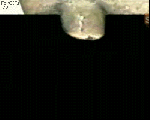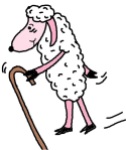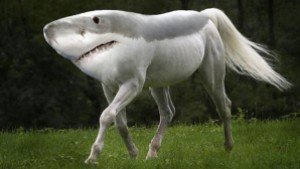A sheep was born
20 years ago today, a group from Scotland (from the Roslin Institute) announced that they have successfully cloned the first mammal from an adult somatic cell. The achievement was in the details – somatic cells (unlike stem cells) are usually very specialized cells which in the multi-cellular organism make up the organs, tissues and structures of the individual. Thus, they need to perform specific complex functions related to the part of the body they are located in. Somatic cells arise from embryonic stem cells in the process of differentiation. This happens when the cell starts switching genes on and off to tune its behavior and speciallize into the specific somatic cell it is dedicated to become. Until then, somatic cells were not known to be able to revert this genetic programming and to be able to produce again a stem cell similar to the embryonic one, and moreover – give rise to an entire new organism, going through the genetic reprogramming stage as if it never have done it before.
Dolly the regenerator
Dolly was the first mammal to be cloned using the nucleus from a somatic cell of one animal and an egg from another individual of the same species. Her birth proved that we can restart the cellular development of a somatic cell from a higher animal in a way that would allow it to recreate any other cell needed to form a whole new individual. Somatic cells of complex higher animals were thought to have only one destiny once they have fulfilled their function – cellular death. Some species were known to be able to regenerate tissues and even whole limbs.  Mammals could do that to a very limited extend by using dormant tissue-specific stem cells, which can be woken up when the surrounding tissue is damaged and with could (with moderate success) replace the dead cells. Think of the way your skin heals after it has been wounded. If the damage was more than just a surface scratch, chances are that a scar will remain on the spot. This is due to the fact that these tissue specific stem cells can go only so far to recreate all the components of the skin as an organ with all its complexity.
Mammals could do that to a very limited extend by using dormant tissue-specific stem cells, which can be woken up when the surrounding tissue is damaged and with could (with moderate success) replace the dead cells. Think of the way your skin heals after it has been wounded. If the damage was more than just a surface scratch, chances are that a scar will remain on the spot. This is due to the fact that these tissue specific stem cells can go only so far to recreate all the components of the skin as an organ with all its complexity.
To Dolly or not to Dolly?
The birth of Dolly raised many questions, both fundamentally biological and especially ethical, that still surf the field today.
 When Dolly died just after her 6th birthday concerns were raised of whether or not she was at all meant to survive as long as the “normal” sheep of her breed (which usually have up to twice as long of a lifespan). The telomeres are regions at the end of each chromosome, which get progressively shorter with every division of the cell due to the nature of the process of copying the DNA between cell divisions. Dolly’s telomeres were shorter than the telomeres a non-clone sheep her age would be expected to have. So naturally, the question was if Dolly was actually born at a more advanced genetic age. Investigating the condition of Dolly’s organism after her death though, did not show any signs of more advanced ageing and diseases related to it than expected. Why were her telomeres shorter and how (if it did) this contribute to her untimely death is a question still to be answered.
When Dolly died just after her 6th birthday concerns were raised of whether or not she was at all meant to survive as long as the “normal” sheep of her breed (which usually have up to twice as long of a lifespan). The telomeres are regions at the end of each chromosome, which get progressively shorter with every division of the cell due to the nature of the process of copying the DNA between cell divisions. Dolly’s telomeres were shorter than the telomeres a non-clone sheep her age would be expected to have. So naturally, the question was if Dolly was actually born at a more advanced genetic age. Investigating the condition of Dolly’s organism after her death though, did not show any signs of more advanced ageing and diseases related to it than expected. Why were her telomeres shorter and how (if it did) this contribute to her untimely death is a question still to be answered.
 The concerns from ethical standpoint were mostly that the technique used to make Dolly was going to be so accessible and easy to use that everyone with basic knowledge in biology would be able to clone any animal and create any hybrid imaginable, including using human cells. These fears though, did not exactly pan out. Other mammals were later created using the nuclear transfer method, but the success rate was much lower than expected – even Dolly was only one out of 277 attempts that succeeded. The difficulty increased for humans, it wasn’t until 2016 when the first baby, mothered by 3 women, was born, and the technique was used to overcome a severe inheritable genetic disease in the mother and still allow her to have a child. And as for the monster-hybrids worries, that proved even harder. The genetic barriers between species hybridization are nowhere sufficiently studied to succeed with high frequency in creating chimera animals.
The concerns from ethical standpoint were mostly that the technique used to make Dolly was going to be so accessible and easy to use that everyone with basic knowledge in biology would be able to clone any animal and create any hybrid imaginable, including using human cells. These fears though, did not exactly pan out. Other mammals were later created using the nuclear transfer method, but the success rate was much lower than expected – even Dolly was only one out of 277 attempts that succeeded. The difficulty increased for humans, it wasn’t until 2016 when the first baby, mothered by 3 women, was born, and the technique was used to overcome a severe inheritable genetic disease in the mother and still allow her to have a child. And as for the monster-hybrids worries, that proved even harder. The genetic barriers between species hybridization are nowhere sufficiently studied to succeed with high frequency in creating chimera animals.
What did Dolly leave us?
The success of the technology used to create Dolly gave us an immense boost in stem cell research. Aside of its incredible fundamental value, this helps us explore the possibilities to treat severe traumas using own for the organism somatic cells.  Currently, the most often used way is to use embryonic stem cells, but in my opinion this poses much more ethical questions than using own mature cells and reverting them to stem cells. We still need to learn how to control stem cells implanted in the adult human body. Their potential to develop into any type of cell also means they are able to turn into cancer cells and this would be, to say the least, undesirable. Recent development in the inter-species hybridization was dramatically misreported in the popular media – the news of a hybrid embryo between a pig and a human. If you are interested in a good explanation of what actually happened, I suggest listening to episode 604 of the Skeptic’s Guide to the Universe podcast, where Cara gives a thorough explanation and a good account of the actual story behind the news hype.
Currently, the most often used way is to use embryonic stem cells, but in my opinion this poses much more ethical questions than using own mature cells and reverting them to stem cells. We still need to learn how to control stem cells implanted in the adult human body. Their potential to develop into any type of cell also means they are able to turn into cancer cells and this would be, to say the least, undesirable. Recent development in the inter-species hybridization was dramatically misreported in the popular media – the news of a hybrid embryo between a pig and a human. If you are interested in a good explanation of what actually happened, I suggest listening to episode 604 of the Skeptic’s Guide to the Universe podcast, where Cara gives a thorough explanation and a good account of the actual story behind the news hype.

Comments